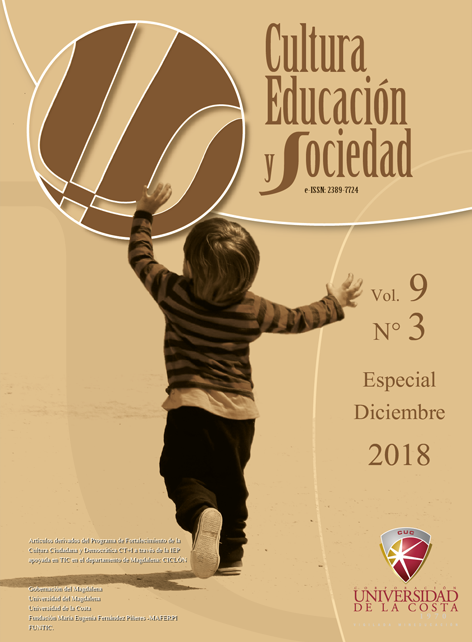Reforestation model with native plants of the Jaraba swamp through the IEP
DOI:
https://doi.org/10.17981/cultedusoc.9.3.2018.67Keywords:
reforestation model, native plants, research as a pedagogical strategy.Abstract
The drought in summer time caused by the direct action of the sun on the coasts because of the loss of vegetation in them, is a reality that affects the riverside populations at present. Reforestation programs are useful tools in improving the quality of life in different parts of the world affected by this reality. The purpose of this study was to design a reforestation model with native plants of the Jaraba swamp through Research as a Pedagogic Strategy (IEP). The methodology was oriented under the qualitative approach, using the type of action research, from a descriptive, exploratory design. For the collection of data, techniques such as; documentary analysis based on the implementation of software that analyzes the characteristics of shrubs and seeds that are conducive to reforestation. The population was conformed by fifty (50) students of the IED Antonio Bruges Carmona ERM headquarters of Jaraba of the Municipality of Santa Ana Magdalena, giving as results the creation of a natural nursery with different species of plants selected for this ecological model. Reaching the conclusion that there is a need to strengthen the environmental culture on the part of the inhabitants and visitors on the banks of the swamp, where all kinds of waste that will hardly reach a level of degradation are poured.
Downloads
References
Banco Mundial (1994). Libro de Consulta para Evaluaci6n Ambiental. I, II y III. Recuperado de http://documentos.bancomundial.org/curated/es/472401468161955207/pdf/WTP1390SPANISH10Box338902B01PUBLIC1.pdf
Cabello-Eras, J. (2016). Acercamiento a la producción más limpia como estrategia de gestión ambiental. International Journal of Management Sciences and Operations Research, 1(1), 4-7. Recuperado a partir de http://ijmsoridi.com/index.php/ijmsor/article/view/71
Canivel, J. (2014). Is the gov't reforestation program planting the right trees? Recuperado de https://www.rappler.com/nation/51200-national-greening-program-native-trees
Delgado, A. Murillo M. y Castillo, M. (2003). Crecimiento de especies forestales nativas en la zona norte de Costa Rica. Agronomía Costarricense. 27(1). 63-78.
FAO. (1999). Situación de los Bosques del Mundo. Recuperado de http://www.fao.org/docrep/W9950S/W9950S00.htm
FAO. (2011). Año Internacional de los Bosques. Recuperado de http://www.fao.org/docrep/013/i2015s/i2015s.pdf
Fundación para la Educación Superior y el Desarrollo - FEDESARROLLO. (2011). Deforestación en Colombia: Retos y perspectivas. Recuperado de http://www.repository.fedesarrollo.org.co/bitstream/handle/11445/337/KAS%20SOPLA_Deforestacion%20en%20Colombia%20retos%20y%20perspectivas.pdf?sequence=2&isAllowed=y
Gobierno de España. Ministerio de Agricultura, alimentación y medio ambiente. (2015). 75° aniversario Plan general de reforestación de España. Recuperado de file:///C:/Users/CharleS/Downloads/03_75_PNRFE_PFE_LGil.pdf
Hernández, R., Fernández, C., & Baptista, P. (2010). Metodología de la investigación. México. Editorial Mc Graw Hill.
ONU. (2014). Avances de la Declaración de Nueva York sobre los Bosques. Recuperado de http://forestdeclaration.org/wp-content/uploads/2015/10/Avances_de_la_Declaración_de_Nueva_York_sobre_los_Bosques-Resumen_Ejecutivo-30-11-15-ES.pdf
ONU. (2015). Acuerdo de París. Recuperado de https://unfccc.int/files/meetings/paris_nov_2015/application/pdf/paris_agreement_spanish_.pdf
República de Colombia. Minambiente. (2016). 100 plantas del Caribe Colombiano. Bogotá, D.C.: Fondo Patrimonio Natural. Recuperado de http://pdf.usaid.gov/pdf_docs/PA00MDS4.pdf
Segura, E. (2016). Información, estabilidad y complejidad de aprendizaje en memorias asociativas. International Journal of Management Sciences and Operations Research, 1(1), 49-53. Recuperado a partir de http://ijmsoridi.com/index.php/ijmsor/article/view/77
Sepúlveda Perico, A., Martínez Castro, R., Medina Roncancio, S., & Salazar Arrieta, F. (2016). Propuesta de diseño de una red supply chain para la agrocadena de cacao, municipio de Viotá, Cundinamarca. International Journal of Management Sciences and Operations Research, 1(1), 35-42. Recuperado a partir de http://ijmsoridi.com/index.php/ijmsor/article/view/75
Comisión Nacional para el Conocimiento y Uso de la Biodiversidad. (2017). Species Plantarum. 1(443). 1753. Recuperado de http://www.conabio.gob.mx/conocimiento/info_especies/arboles/doctos/58-rhizo1m.pdf
Downloads
Published
How to Cite
Issue
Section
License
Copyright (c) 2018 CULTURA EDUCACIÓN Y SOCIEDAD

This work is licensed under a Creative Commons Attribution-NonCommercial-NoDerivatives 4.0 International License.
![]()
Creative Commons 2020 CULTURA EDUCACIÓN Y SOCIEDAD
This article is under international license Creative Commons Reconocimiento-NoComercial-SinObrasDerivadas 4.0.
The published articles are the sole responsibility of their authors and do not necessarily reflect the opinions of the editorial committee.
CULTURA EDUCACIÓN Y SOCIEDAD respects the moral rights of its authors, who assign to the editorial committee the patrimonial rights of the published material. In turn, the authors inform that this work is unpublished and has not been previously published.
All articles are under a:
Licencia Creative Commons Atribución-NoComercial-SinDerivadas 4.0 Internacional.
![]()


 English
English
 Español (España)
Español (España)




_12.53_.27_p_. m_._3.png)





_12.57_.35_p_. m_._3.png)
_12.50_.37_p_. m_._3.png)



